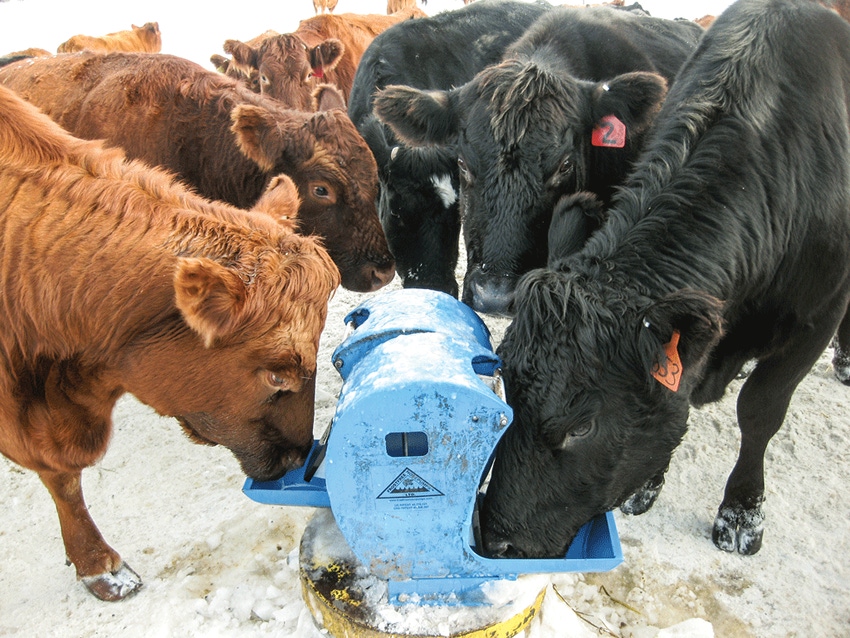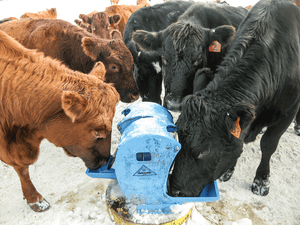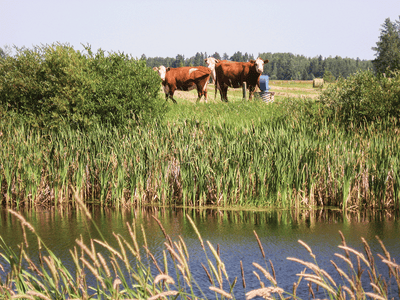How to let your cattle pump their own water
Tired of chopping ice and hauling water? Here’s a solution.
October 12, 2015

Cold weather can present challenges for watering cattle, especially in areas with no electricity. Jim Anderson, Rimbey, Alberta, Canada, solved this problem more than 15 years ago by creating an innovative water system where cattle pump water for themselves from shallow wells, ponds or pressure systems — water that never freezes, even at 40 degrees F below zero.
Anderson’s innovation is a piston pump, like the old-fashioned hand pump where you work the handle up and down to lift water. “We modified this so cattle could push a lever with their nose. This operates the piston pump by raising and lowering the piston in the cylinder, the same as a handle did,” he explains.

By capturing geothermal heat from the ground, the water basins remain frost-free — even in subzero weather.
“Like the old-fashioned hand pump, we have a 3-inch cylinder down inside the well. This is how we made this pump frost-free; we capture enough geothermal heat from the ground, and contain that heat all the way up to the surface, to keep the water in the pipe from freezing,” he says.
The waterer is a small enclosed basin on the top end of a vertical culvert, with a lever at the back of the basin that cattle push. The water pipe that attaches to the lever is down inside the culvert. The culvert sticks up about 2 feet above the ground and goes down to whatever depth is required to make use of groundwater, or water from the bottom of a pond or dugout.
Water from a pond flows through a horizontal underground pipe to the bottom of the culvert, where it then rises to the same level as the pond surface — but it won’t freeze. A buried collection tank from a spring also works. A regular well can be used, as long as the water level comes up to within 50 feet (and preferably 30 feet or less) from the surface.
“Some ranchers use large pipes, but the typical installation is a road culvert at least 24 inches in diameter, set in the ground 20 feet or more. The two factors that determine how much geothermal heat you’ll gain are how deep you go, and how big a diameter pipe [culvert] you take to that depth. The bigger the pipe [culvert], the more opportunity for heat to rise, to keep the water pipe in the center warm enough,” explains Anderson.
Riparian protection
Kip Panter works for the USDA Agricultural Research Service Poisonous Plant Research Laboratory in northern Utah and has a small ranch at Richmond, Utah. He has been using nose pumps for eight years. A creek runs through his place, and he responded to a Natural Resources Conservation Service cost-share offer to fence off riparian areas. “They were willing to do a 75%-25% split, and had information on nose pumps. They asked if I would be a test case,” says Panter.
“I put in the pumps, following Anderson’s instructions, since I enjoy installing things myself. The NRCS paid 75%, and my labor to install it was my 25% of the deal,” he says. This watering system is a good way to provide an alternate source of clean water for cattle away from riparian areas.
“Our winter temperature gets down to 25 below zero sometimes, but the nose pumps never freeze up — and work great. The only downside is that small calves have a little trouble pumping, so in hot weather these pumps may not be adequate as the only water source for a cow-calf herd. There’s a second setting that is not as hard to pump, however, that works for calves in summer,” says Panter.

While ponds and creeks can be good water sources for cattle, protecting riparian areas is important.
“The water is always fresh and clean, compared to a pond. It doesn’t take cattle very long to figure it out. You just fill the pan, so they know where the water is. With my first group of cows, I just pushed the lever and filled it and walked away, and when I came back one cow had figured it out and was showing the rest how to do it. Anderson recommends that you always leave one cow there that knows how to use it, whenever you put in a new group. I’ve never worried about that. They smell the water and know it’s there, and figure it out very quickly,” says Panter.
“These pumps are maintenance-free, but I check mine every few days or once a week in winter, just to make sure it’s working — but it always is. Since the water coming in is always clean, and the pan is empty except when cattle are actively using it, the pan stays clean. You never have moss or algae in summer, and no water is left in it to freeze in winter,” he says.
“The structure is very strong and robust. I built my own lids out of steel and bolted them on. I’ve had bulls using them, and they’ve rubbed on them and never hurt them,” Panter says. The pumps are foolproof, he says. However, if bulls are going to use the pumps, he would reinforce the corners to protect the pump.
He put a 20-by-20-foot concrete pad around his pumps, so cattle are never standing in mud. “The pad is 4 inches thick, and I put a 3-inch insulated Styrofoam piece underneath it, on top of a gravel base. This insulates the ground around the pump, though I probably overdid it and wouldn’t need that much insulation for cold weather,” he says.
Panter’s pumps are located near a creek. “Groundwater is fairly near the surface. I had a backhoe dig a hole about 18 feet deep — as far as the backhoe would dig — and put a perforated culvert down the hole and filled the hole around it with gravel, within 10 to 12 feet of the surface [then backfilled the remainder with dirt]. Groundwater seeps in through the gravel and perforated culvert, even though the creek almost dries up in late summer,” he says. The creek sometimes freezes over in winter, but water in the pump culvert never freezes.

70 photos show ranchers hard at work on the farm
Readers have submitted photos of hard-working ranchers caring for their livestock and being stewards of the land. See reader favorite photos here.
“I’ve had as many as 40 cattle on a pump. Some ranchers have 80 or more on one pump and do fine. Mine is a single-basin, but you can make it double so more cattle can drink at once. I have two pumps, set up in different paddocks,” says Panter.
These pumps are ideal for summer as well as winter, especially to keep cattle away from riparian areas. “This is a sensitive issue with government regulators. My animals were watering in a creek. I was being faced with having to get them out of the creek, so this solution was ideal. I fenced the creek and moved the cattle away from it. One of my pumps is 60 feet away from the creek,” he says.
Year-round water
Lowell Thorson, Edinburg, N.D., has been using two nose pumps for nine years. “I use one nose pump exclusively in the winter. The other I use year-round with cow-calf pairs and a bull in that pasture during summer,” he says.
“When weather is cold, there’s sometimes ice buildup because of the water flying around as they are pumping it, so I check it now and then to knock ice off — so it won’t build up so much it stops the lever action. It sometimes gets stuck in the back position, and I just have to break it loose. Other than that, there’s never been a problem having it provide adequate water for the animals,” he says.
He rents a pasture that has a water hole, and the farmer who owned it used to let his cows drink there. “They often got stuck in the water hole. I put a fence around it to keep them out. It’s much safer to have them drink from the nose pump than go into the pond, and it’s always nice clean, cool water.”
Thorson runs pairs there after they calve. “The only problem I ever had with that pump was because I had the foot valve set too low in the well, and the screen over it plugged with mud. I took it out and got it cleaned out, and then it worked fine,” he says.

BEEF Seedstock 100
Looking for a new seedstock provider? Use our BEEF Seedstock 100 listing to find the largest bull sellers in the U.S. Browse the Seedstock 100 list here.
“It’s a neat invention, not having to depend on electricity. It’s never had any mechanical problems. The fewer moving parts, the better, and nose pumps don’t have very many moving parts! There is very little that can go wrong,” he says.
“This type of water system won’t fit every location or need, but it’s a wonderful option for many situations, and cows enjoy it. Anywhere there’s water close enough to the surface for the cows to pump their own water, this is very handy. Cows have the muscle and enthusiasm to do the work to water themselves,” Thorson says.
Editor's Note--the name of the company that makes the nose pumps is Frostfree Nosepumps, Ltd.
Heather Smith Thomas is a rancher and freelance writer based in Salmon, Idaho.
You might also like:
15 photos showcase hardworking American ranchers
Genetic accident produces White Angus
What's the best time to castrate calves? Vets agree the earlier the better
Burke Teichert shares the secrets of a profitable cow
You May Also Like



